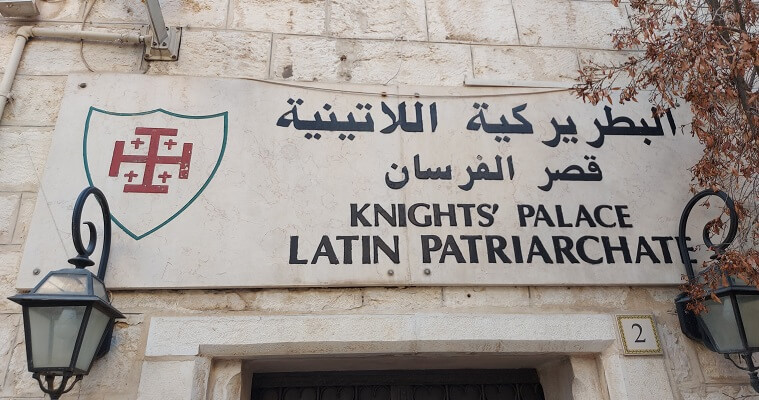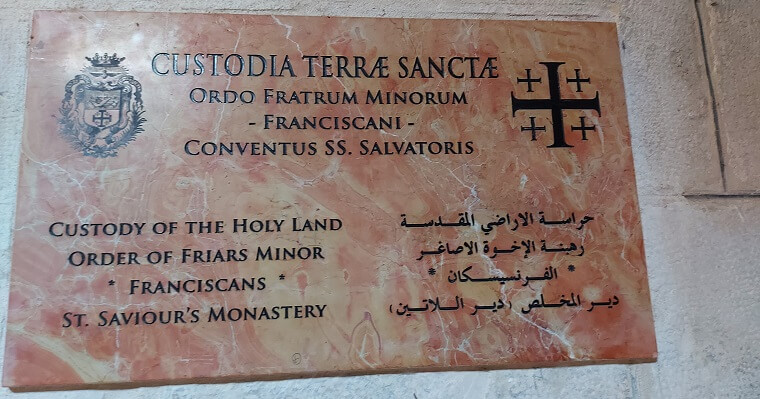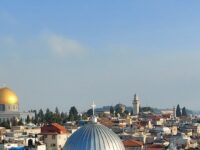Christian Orders Supporting the pilgrimage to Jerusalem
Throughout history, from the establishment of the Via Palma Pilgrimage route to the present day, two Christian Orders have distinguished themselves as invaluable supporters and facilitators of pilgrims and the pilgrimage experience: the Order of the Knights of the Holy Sepulchre and the Custodia Terra Sancta of the Franciscans. In the following article, you can learn more about their history and structure.

Order of the Knights of the Holy Sepulchre
Catholic Christianity boasts a global following of approximately one billion adherents, with its leadership centered around the Pope in Rome. Over its two-thousand-year history, numerous orders of monks and nuns have been established within the Church. However, starting from the Middle Ages, monastic knight orders also emerged, among the most renowned being the Templars, the Hospitallers, and the Teutonic Orders, all founded during the Crusades.
Less well-known, yet still enduring to this day, is the “Order of the Knights of the Holy Sepulchre.” This order, unlike some of its counterparts that have since disbanded, remains active. It is a third-order religious order, meaning it is open to married individuals. Serving as a cornerstone of support for the Christian presence in Israel, this order operates under the direct patronage of the Pope.
The Order of the Holy Sepulchre holds significant importance among Catholics worldwide and particularly within Israel. It stands as one of the foremost international organizations supporting the Catholic presence in Israel, closely associated with the Latin Patriarchate in Jerusalem. The primary objective of the Order is to uphold and sustain the Christian presence in the Holy Land, boasting a membership of 30,000 knights. Currently led by Cardinal Fernando Filoni as its Grand Master, the Order’s administrative hub is situated in Rome at the Palazzo Della Rovere. The Latin Patriarch of Jerusalem serves as the deputy head of the Order, effectively overseeing its operations and activities.
The Order traces its origins back to the first Crusader King, Godefroy de Bouillon, who established it. To this day, the original sword wielded by Godefroy is utilized in the solemn ceremonies where knights are initiated into the order. These ceremonies, known as Dubbing ceremonies, take place at night within the Church of the Sepulchre. In 1099, following the conquest of Jerusalem, the knight Girolamo Gabrielli from Umbria led a group of a thousand knights into the Church of the Sepulchre. This momentous event marked the beginning of a tradition where knights were dubbed within the sacred confines of the church. Before Jerusalem’s liberation, crowning ceremonies for knights typically occurred in churches, but Jerusalem’s Muslim rule prohibited such proceedings. Consequently, any knight could dub worthy individuals anywhere at their discretion. However, with Jerusalem under Crusader control, many warriors who had valiantly served in the wars were officially dubbed as knights within the hallowed halls of the Church of the Holy Sepulchre.
Following the Crusader conquest, the Canons Regular of the Holy Sepulchre, an order of priests dedicated to overseeing the Church of the Holy Sepulchre, was established. Concurrently, a defense force known as the Milites Sancti Sepulcri was created, which eventually evolved into the Order of the Knights of the Holy Sepulchre. In 1103, Crusader King Baldwin I authored the constitution for the order, stipulating that its members would belong to the third order religious (monks who are not bound by monastic vows and thus can marry), and the order embraced the Rule of St. Augustine. Hugo de Paine, who would later found the Templar Order, initially belonged to the Order of the Holy Sepulchre before joining the Templars.
In 1244, the Crusaders lost control of Jerusalem and the Church of the Holy Sepulchre, eventually losing all their territories in the Land of Israel. By 1291, the Crusaders were expelled from the region, and stewardship of the holy sites, including the Church of the Holy Sepulchre, transitioned from the Order of the Knights of the Holy Sepulchre to the Franciscan Order, which established the Custody of the Holy Land (Custodia Terrae Sanctae). Consequently, the Order of the Knights of the Holy Sepulchre saw a decline in its status, and pilgrimages to the holy sites continued under the protection of the Custodia de Terra Santa and the Mamluk government.
Starting in 1335, knights among the pilgrims were once again honored with chivalric ceremonies in the Church of the Holy Sepulchre, where numerous European monarchs and nobles were knighted during nocturnal ceremonies. Upon returning to their home countries, some of these knights constructed churches reminiscent of the Church of the Holy Sepulchre. By the early 20th century, the practice of knighting members of the order expanded beyond the Church of the Holy Sepulchre to various locations worldwide.
From the late 19th century, the newly appointed Latin Patriarchs of Jerusalem closely aligned with the Order of the Knights of the Holy Sepulchre, leveraging it as a means to bolster Christian life in Israel and to rally global Christian support to reinforce the Christian community in Israel. It’s suggested that they might have quietly harbored hopes for a Christian resurgence in the Holy Land in some form. Consequently, the Order of the Knights of the Holy Sepulchre contributes 10 million dollars annually to the Latin Patriarchate of Jerusalem. The Order’s emblem, mirroring that of the Kingdom of Jerusalem, features five crosses, and its motto is “Deus Lo Vult” (God Wills It).
The emblem of the Order is emblazoned on a knightly shield, flanked by two angels, one wielding a javelin and the other a pilgrim’s staff, representing the dual nature of journeys to the Holy Land—both spiritual and political. A shell is depicted on the angels’ chests, possibly linking to the pilgrimage routes to Santiago de Compostela, given the Order’s historical support for pilgrimages to sacred sites, particularly Santiago. Membership in the Order of the Knights of the Holy Sepulchre is exclusively by invitation, comprising local Christians as well as distinguished Catholics globally, including royalty, nobility, and business leaders. Joining the Order requires a donation, mirroring the contributions made by pilgrims on their voyage to the Holy Land.
Members of the Order of the Knights of the Holy Sepulchre must refrain from affiliating with organizations not recognized by the Pope, such as the Freemasons, and can face expulsion for misconduct. The Order inclusively bestows knighthood on women, who are titled Dames. An emblem of distinction within the Order is the “Palm of Jerusalem,” which might evoke the memory of the “Via Palma.” Pilgrims journeying to Jerusalem are awarded the pilgrim’s shell, symbolizing their pilgrimage. Additionally, there’s the Pilgrim’s Cross Medal, bestowed by the Franciscan Order. The Order also honors individuals who perform noble deeds, regardless of their religious affiliation, with the Medal of Merit, recognizing their contributions to the principles the Order upholds.

Custodia de Terra Santa
The Franciscan Order was formally established in 1219, two decades following Saladin’s recapture of Jerusalem from the Crusaders. During that same year, Saint Francis, accompanied by Brother Elias, journeyed to Israel. Initially arriving in Egypt with the Fourth Crusade, Saint Francis held a notable encounter with Sultan Al-Kamil. This meeting resulted in the Sultan granting the Franciscans the freedom to move and operate across his realm. In a recent conversation with the current head of the Custodia Terrae Sanctae, Father Francesco Patton, he shared that this interaction with the Sultan profoundly impacted Francis. He advised his brethren to engage with Muslims without seeking conflict and to treat them with respect.
From the outset of the Order, while Francis was still alive, the monks were encouraged to expand their presence by establishing new districts. Following St. Francis’s lead, other Franciscan monks began arriving in Israel. In 1229, a decade after the Order was founded, the Sixth Crusade, led by Frederick II, enabled Christians to reclaim Jerusalem, with the exception of the Dome of the Rock. Christian narratives suggest that Frederick II brought Franciscan monks to Jerusalem, where they established their headquarters near the fifth station of the Via Dolorosa, the site where Simon of Cyrene is said to have assisted Jesus in carrying the cross. During this period, Pope Gregory IX favored the Franciscans, canonizing Francis in 1228, and commissioning the cathedral in Assisi. In 1230, he issued a papal bull confirming the establishment of the Friars Minor in the Holy Land.
Gregory IX is regarded as one of the most pivotal popes, who achieved notable deeds such as the establishment and fortification of the orders of the friars (notably the Franciscans) and the scholarly monks (the Dominicans, whom he supported by canonizing Dominic in 1234). He bolstered the University of Paris, fostering academic pursuits within the Christian context—a move that complemented the support for the Dominican Order, which produced eminent scholars like Thomas Aquinas. He authored a Papal Bull titled “Mother of the Sciences,” hailed as the academic world’s Magna Carta. Conversely, Gregory IX engaged in national and political conflicts, most notably with Frederick II, which led to turmoil in Italy, and launched a crusade against the Cathars in southern France. He was instrumental in establishing the Inquisition to combat the Cathar heresy, sanctioning extreme measures in the name of Christianity.
It is suggested that due to the misdeeds attributed to Christianity, Christians were fated to lose control over Jerusalem. Consequently, in 1244, the Khwarezmians—a group of Turkish Muslim warriors from Central Asia who briefly occupied parts of the Middle East—invaded the Land of Israel. They captured Jerusalem, expelled the Christian inhabitants, and along their path, killed the Franciscan monks and others present. Following this event, there was no official Christian presence in Jerusalem until the mid-14th century, when Franciscan monks were permitted to return and reestablish their connection to the sacred sites, filling the void left behind.
In 1291, following the fall of Acre, the last of the crusaders, including the Franciscan Order, were expelled from Israel. This expulsion, however, did not hinder the Franciscans from being considered the theoretical guardians of the Holy Places. By the mid-14th century, they had returned and formally assumed the role of guardians of these sites. The Franciscans are responsible for eight significant Holy Places, termed as “temples of redemption” (for example, the Church of the Nativity in Bethlehem), in addition to numerous other churches, monasteries, and sacred sites throughout the land. The leader of the Franciscans in Israel took over from the Crusader kings of Jerusalem as the head of the Order of the Holy Sepulchre. From that point onwards, they have been known as the “Custodia Terrae Sanctae” or the Custody of the Holy Land.
In 1333, the Franciscans reached an agreement with the Mamluk rulers, under which the Mamluks acknowledged the Franciscans’ custodianship over Christian Holy Places. Concurrently, the Franciscans began to cultivate the tradition of the Via Dolorosa, likely motivated by the desire to establish a sacred geography for pilgrims or to secure a presence in parts of Jerusalem with a Muslim majority, such as the Muslim quarter where most of the Via Dolorosa stations are situated. The Franciscans incorporated three additional stations to the path, marking the spots where Jesus is believed to have fallen three times during his journey to crucifixion, corresponding to stations three, seven, and nine. Furthermore, they introduced another station to commemorate a supposed encounter between Jesus and a woman named Veronica at the sixth station. The name Veronica itself conveys ‘the true image’ (from the Latin ‘vero’ for true and ‘icon’ for image). Legend has it that Veronica offered Jesus a cloth to wipe his face. When she received it back, the cloth bore the imprint of Jesus’s face, turning it into a revered relic within Catholic Christianity.
Under Mamluk rule, the activities of the Franciscan monks received support from the kings of Naples and the leading Italian maritime forces, notably Venice. The Mamluks, interested in fostering their lucrative trade relationships with Europe, recognized the importance of maintaining positive relations with the Christian communities.
In 1342, Pope Clement VI, one of the Avignon popes renowned for his efforts to protect Jews during the Black Plague, formally designated the Franciscans as the custodians of the Holy Places in the Holy Land. He directed them to establish a permanent presence there, including overnight stays, essentially mandating the founding of monasteries. While specific details from this era are scarce, this development likely paved the way for the Custodia de Terra Santa to form an international network of representatives by the early 15th century. These representatives were tasked with raising funds to maintain the Holy Sites in Israel and support the Custody’s other roles, such as aiding the local Christian communities in Israel. Known as commissioners, they continue to fulfill this vital role today, with around 100 active members worldwide.
The Via Dolorosa was officially established in the 15th century with the support of the Custodia de Terra Santa. Although not all stations have been finalized, a prayer book for the stations has been prepared. More importantly, Franciscans worldwide have started replicating the Via Dolorosa stations in Christian churches across the Catholic realm.
Overall, Franciscan monks globally belong to one of three orders, with the Franciscan Friars Minor being the largest, comprising approximately 15,000 members, including the Custodia Terra Santa as a branch. The other two orders, the Capuchins and the Conventuals, collectively have about 15,000 members.
The Custodia Terra Santa comprises approximately 300 monks and 100 nuns. It is tasked with the upkeep and protection of sacred sites in the Holy Land (including some locations outside Israel), offering religious services to Catholics in Israel, Lebanon, Syria, Jordan, Egypt, Rhodes, and Cyprus, as well as providing educational services to local Christians. They oversee dozens of schools with 11,000 students, renowned for their excellence in the Arab sector, attracting a significant number of Muslim students and those from various Christian denominations. Notably, the Custodia operates a music school in Jerusalem, inspired by what Pope John Paul II termed “the way of beauty,” or the path through art, fostering Christian values and collaborative creation.
The Custodia is actively involved in researching and documenting the Land of Israel. They operate an independent research institute, run a publishing house for books, maintain their own museum, and oversee a Bible school. This school conducts independent archaeological excavations and is situated at the second station of the Via Dolorosa, functioning as a branch of the Pontifical University in Rome. Additionally, they have an archaeological institute in Madaba, Jordan, and a center dedicated to the study of Eastern Christianity located in Cairo.
A key focus of the Custodia Terra Santa is organizing and guiding groups of pilgrims to the Land of Israel, as well as supporting other Christian pilgrims by arranging their visits to sacred sites and assisting in the organization of religious services. The Custodia operates a Christian Information Center at the Jaffa Gate, which provides information about holy sites and is accessible to everyone. This center is an excellent resource for planning visits to Christian locations in Jerusalem and its vicinity. Additionally, the Custodia offers accommodation at several Casa Nova establishments, including one in Jerusalem, to facilitate the stay of pilgrims. The Franciscans refer to the pilgrimage to the Holy Land as the “Fifth Gospel.” They award a medal known as the “Pilgrim’s Cross” to those pilgrims who have completed the designated route and met the pilgrimage criteria, which include praying and visiting specific sites. This medal is a token of recognition given by the Pope.
The Custodia de Terra Santa oversees more than 70 churches and sacred sites in Israel, in addition to over 20 monasteries and 15 communities. They also own upwards of 2,000 residences, offering housing to Christian communities across the nation. Their global headquarters is located at the San Salvador Monastery in the Christian quarter, functioning as a small city with facilities for seminars, a bakery, a printing house, among other amenities. Furthermore, they extend religious services to numerous foreign workers in Israel, notably those from the Philippines.
My understanding indicates that the Franciscans’ Custodia Terra Sancta and the Order of the Knights of the Holy Sepulchre are in a prime position to significantly aid in the revival of the “Via Palma” at present. As such, I have explored these two organizations more thoroughly. They are dedicated to promoting pilgrimages to the holy sites in Israel, with a special focus on the Church of the Holy Sepulchre and essential Christian locations in Jerusalem, Bethlehem, and Jordan. These sites were pivotal to pilgrimages during the era of the Second Crusader Kingdom in the Middle Ages and are integral to the tradition of the Via Palma. It is hoped that their support will be instrumental in the reestablishment of this tradition today.





